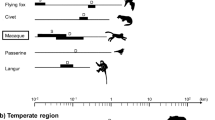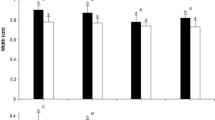The relationships between fruit morphology and the foraging behavior of the Yakushima macaque, Macaca fuscata yakui were studied during a 9-month field study and series of laboratory experiments on Yakushima Island, southern Japan. These relationships may affect seed germination traits through seed dispersal. The macaques’ foraging behavior was observed in order to obtain data concerning the treatment of pulp and seeds. Seeds in feces and spat seeds were collected and analyzed. A linear discriminant analysis of the data led to the following results: (i) an increase in the relative flesh volume of a fruit was one of the potential factors which increased the probability of seed dispersal by the macaques; and (ii) seed size was an important parameter in relation to the type of seed dispersal (by defecation or spitting out). The germination test was conducted in a laboratory, then the germination rates and delays of dispersed seeds were compared with those of seeds collected directly from trees. The germination of dispersed seeds of Ficus thunbergii, Eurya japonica, and Vaccinium bracteatum, was significantly enhanced by passage through the macaques’ gut. The enhanced germination behavior was not seen in larger seeds, such as those of Psychotria serpens, Myrsine seguinii, Diospyros morrisiana, and Neolitsea sericea. The germination enhancement in small-seeded plants could be due to a sorting effect from the passage through the gut, which selects seeds with a narrower range of germination traits.
Similar content being viewed by others
REFERENCES
Agetsuma N. (1995) Dietary selection by Yakushima macaques (Macaca fuscata yakui): The influence of availability and temperature. International Journal of Primatology 16: 611–627.
Altmann J. (1974) Observational study of behavior: Sampling Methods. Behavior 47: 227–267.
Barnea A., Yom-Tov Y., Friedman J. (1990) Differential germination of two closely related species of Solanum in response to bird ingestion. Oikos 57: 222–228.
Chapman C. A. (1989) Primate seed dispersal: The fate of dispersed seeds. Biotropica 21: 148–154.
Chapman L. J., Chapman C. A., Wrangham R. W. (1992) Balanites wilsoniana: Elephant dependent dispersal? Journal of Tropical Ecology 8: 275–283.
Corlett R. T. (1996) Characteristics of vertebrate-dispersed fruits in Hong Kong. Journal of Tropical Ecology 12: 819–833.
Corlett R. T. & Lucas P. W. (1990) Alternative seed-handling strategies in primates: Seed-spitting by long-tailed macaques (Macaca fascicularis). Oecologia 82: 166–171.
Debussche M. & Isenmann P. (1989) Fleshy fruit characters and the choices of bird and mammal seed dispersers in a Mediterranean region. Oikos 56: 327–338.
Estrada A. & Coates-Estrada R. (1991) Howler monkeys (Alouatta palliata), dung beetles (Scarabaeidae) and seed dispersal: Ecological interactions in the tropical rain forest of Los Tuxtlas, Mexico. Journal of Tropical Ecology 7: 459–474.
Fukui A. W. (1995) The role of the brown-eared bulbul Hypsypetes amaurotis as a seed dis-persal agent. Researches on Population Ecology 37: 211–218.
Galetti M. & Pedoroni F. (1994) Seasonal diet of capuchin monkeys (Cebus apella) in a semideciduous forest in south-east Brazil. Journal of Tropical Ecology 10: 27–39.
Garber P. A. (1986) The ecology of seed dispersal in two species of Callitrichid primate (Saguinus mystax and Saguinus fuscicollis). American Journal of Primatology 10: 155–170.
Gautier-Hion A., Gautier J.-P., Maisels F. (1993) Seed dispersal versus seed predation: An inter-site comparison of two related African monkeys. Vegetatio 107/108: 237–244.
Hemingway C. A. (1996) Morphology and phenology of seeds and whole fruit eaten by Milne-Edwards’ sifaka, Propithecus diadema edwardsi, in Ranomafana national park, Madagascar. International Journal of Primatology 17: 637–659.
Hill D. A. (1997) Seasonal variation in the feeding behavior and diet of Japanese macaques (Macaca fuscata yakui) in lowland forest of Yakushima. American Journal of Primatology 43: 305–322.
Hill D. A., Lucas P. W., Cheng P. Y. (1995) Bite forces used by Japanese macaques (Macaca fuscata yakui) on Yakushima Island, Japan to open aphid-induced galls on Distylium racemosum (Hamamelidaceae). Journal of Zoology 237: 57–63.
Hutchins H. E. & Lanner R. M. (1982) The central role of Clark’s Nutcracker in the dispersal and establishment of whitebark pine. Oecologia 55: 192–201.
Julliot C. (1996) Seed dispersal by red howling monkey (Alouatta seniculus) in the tropical rain forest of French Guiana. International Journal of Primatology 17: 239–258.
Kinzey W. G. & Norconk M. A. (1993) Physical and chemical properties of fruit and seeds eaten by Pithecia and Chiropotes in Surinam and Venezuela. International Journal of Primatology 14: 207–227.
Kuroda K. (1984) On the morphological features of Yaku monkeys. Monkey 197/198/199: 14–17 (in Japanese).
Larcher W. (1995) Physiological Plant Ecology: Ecophysiology and Stress Physiology of Functional Groups, 3rd edn. Springer-Verlag, Berlin.
Lieberman M. & Lieberman D. (1986) An experimental study of seed ingestion and germination in a plant–animal assemblage in Ghana. Journal of Tropical Ecology 2: 113–126.
Lucas P. W. & Corlett R. T. (1998) Seed dispersal by long-tailed macaques. American Journal of Primatology 45: 29–44.
Mack A. L. (1993) The sizes of vertebrate-dispersed fruits: A Neotropical–Paleotropical comparison. American Naturalist 142: 840–856.
Milton K. (1981) Food choice and digestive strategies of two sympatric primate species. American Naturalist 117: 496–505.
Noma N. & Yumoto T. (1997) Fruiting phenology of animal-dispersed plants in response to winter migration of frugivores in a warm temperate forest on Yakushima Island, Japan. Ecological Research 12: 119–129.
Norconk M. A., Wertis C., Kinzey W. G. (1997) Seed predation by monkeys and macaws in eastern Venezuela: Preliminary findings. Primates 38: 177–184.
Oliveira-Filho A. T. & Galetti M. (1996) Seed predation of Cariniana estrellensis (Lecythidaceae) by black howler monkeys, Alouatta caraya. Primates 37: 87–90.
Passos F. C. (1997) Seed dispersal by black lion tamarin, Leontopithecus chrysopygus (Primates: Callitrichidae), in southeastern Brazil. Mammalia 61: 109–111.
Peres C. A. (1991) Seed predation of Cariniana micrantha (Lecythidaceae) by brown capuchin monkeys in Central Amazonia. Biotropica 23: 262–270.
Reynolds V., Plumptre A. J., Greenham J., Harborne J. (1998) Condensed tannins and sugars in the diet of chimpanzees (Pan troglodytes schweinfurthii) in the Budongo Forest, Uganda. Oecologia 115: 331–336.
Rowell T. E. & Mitchell B. J. (1991) Comparison of seed dispersal by guenons in Kenya and capuchins in Panama. Journal of Tropical Ecology 7: 269–274.
Sas Institute Inc (1988) SAS/STAT User’s Guide, Release 6.03., SAS Institute Inc., Cary, North Carolina, USA.
Satake Y., Hara H., Watari S., Tominari T. (eds). (1989) Wild Flowers of Japan: Woody Plants. Heibonsha Publishers, Tokyo (in Japanese).
Satomi K. chief, eds (1980) Propagation of Tree Species. Norin Shuppan, Tokyo (in Japanese).
Suzuki S., Hill D. A., Maruhashi T., Tsukahara T. (1990) Frog- and lizard-eating behavior of wild Japanese macaques in Yakushima, Japan. Primates 31: 421–426.
Tagawa H. (1980) Vegetation on the western slope of Mt Kuniwaridake, Yakushima island. Science Reports of Kagoshima University 29: 121–137 (in Japanese).
Takasaki H. (1981) Troop size, habitat quality, and home range area in Japanese macaques. Behavioral Ecology and Sociobiology 9: 277–281.
Takasaki H. (1983) Seed dispersal by chimpanzees: A preliminary note. African Study Monographs 3: 105–108.
Takeuchi T. (1975) Propagation of Planting Tree. Soubun, Tokyo (in Japanese).
Traveset A. & Willson M. F. (1997) Effect of birds and bears on seed germination of fleshy-fruited plants in temperate rainforests of southeast Alaska. Oikos 80: 89–95.
Tutin C. E. G., Parnell R. J., White F. (1996) Protecting seeds from primates: Examples from Diospyros spp. in the Lope Reserve, Gabon. Journal of Tropical Ecology 12: 371–384.
Tutin C. E. G., Williamson E. A., Rogers M. E., Fernandez M. (1991) A case study of a plant–animal relationship: Cola lizae and lowland gorillas in the Lope Reserve, Gabon. Journal of Tropical Ecology 7: 181–199.
Wrangham R. W., Chapman C. A., Chapman L. J. (1994) Seed dispersal by forest chimpanzees in Uganda. Journal of Tropical Ecology 10: 355–368.
Yagihashi T., Hayashida M., Miyamoto T. (1998) Effects of bird ingestion on seed germination of Sorbus commixta. Oecologia 114: 209–212.
Yumoto T., Noma N., Maruhashi T. (1998) Cheek-pouch dispersal of seeds by Japanese monkeys (Macaca fuscata yakui) on Yakushima island, Japan. Primates 39: 325–338.
Author information
Authors and Affiliations
Corresponding author
About this article
Cite this article
Otani, T., Shibata, E. Seed dispersal and predation by Yakushima macaques, Macaca fuscata yakui, in a warm temperate forest of Yakushima Island, southern Japan. Ecol Res 15, 133–144 (2000). https://doi.org/10.1046/j.1440-1703.2000.00330.x
Received:
Accepted:
Issue Date:
DOI: https://doi.org/10.1046/j.1440-1703.2000.00330.x




